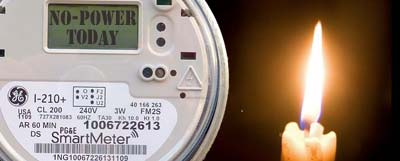
Long considered rumor and conspiracy gossip, utilities are now confirming they can indeed control the flow of electricity into homes using wireless communication with the Smart Grid. Under pilot programs in cooperation with the Department of Energy, regional power companies such as EPB in Chattanooga, Tennessee may cut the flow of electricity to specific appliances in the homes of their customers during times of peak use.
According to Danna Bailey, spokesperson for EPB, homeowners who voluntarily enroll in these schemes can save money by giving the utility the option of limiting power to high usage systems in the home or on the property when strain on the grid is most pronounced.
Specifically targeted for efficiency are water heaters, air conditioning systems and heaters for outdoor swimming pools, said Bailey. In a recent program offered by EPB, which was funded by a grant in the 2009 American Recovery and Reinvestment Act, customers could save money by adding a wireless device, approximately the size of a garage door remote, onto the assigned appliances which would allow the electric flow to be controlled by the utility company.
Bailey reports homeowners enrolled in the program were oblivious to the interruptions even during high demand times. “Our customers did not see a reduction in service,” she said, also explaining the only way EPB could control energy service was through the add-on device. Without the communication from that device, she said, “There is no way we could know what appliances the customer is using.”
The add-ons are part of a classification of new technology products termed “demand response,” where remote access is granted to the utility through Smart Grid wireless transmission from connected systems, such as whole-house thermostats. Minneapolis-based
Honeywell recently rolled-out a line of Wi-Fi thermostats which offer consumers an app that allows them to receive notifications when an “energy-savings event,” the company’s term for electric stoppage, is being exercised.
These cost savings plans, with names such as “
Peaksaver Plus,” are available in a number of states and Canadian provinces, and offer a variety of incentives to electric customers, including rebates and the promise of utility bill savings. Companies involved in producing demand response technologies, as well as utilities, insist they are committed to keeping consumers in control of the process. “We have a whole lot of respect for our customers,” said Bailey in answer to the concern that utilities, instead of homeowners, would manage private energy use.
Electric companies, for their part, are pressed between the controversies over private control in the shadow of Smart Grid, and the external demands they face when trying to provide power under increased regulation. Utilities are currently forced to pay for compliance with state and provincial mandates to develop renewable energy sources, costs that are passed along to consumers. Homeowners, then, find themselves pushed toward the higher efficiency and lower costs promised in the new gadgets. (Sources:
Here,
here, and
here)
Electric utilities are also reacting to a reportedly fraying infrastructure. The U.S. Department of Energy asserts these “smart” technologies are necessary to upgrade the national grid in order to meet decidedly
controversial claims of climate change. According to DOE, utilities must update to match the increasing “
frequency and intensity of extreme weather events.” Taxpayers, as usual, are on the hook. In their web article, “
Top 9 Things You Didn’t Know About America’s Power Grid,” DOE reports more than five billion dollars have already been paid in the past 10 years to upgrade what is still considered a vulnerable power transfer system.
Despite questions over climate change as a basis for installing these micro brown-out devices, utilities and manufacturers continue marketing them. At this time, consumers still determine how widespread the integration of demand-response technologies will be in American and Canadian homes. The choice of electricity control, say the utilities, will be entirely up to them.
